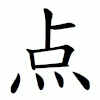点
| ||||||||
Translingual
| Stroke order | |||
|---|---|---|---|
 | |||
| Stroke order | |||
|---|---|---|---|
| Japanese | 点 |
|---|---|
| Simplified | 点 |
| Traditional | 點 |
Etymology
Simplified from 點 (diǎn) (黑 → 灬 (huǒ)). Note that 黑 changed from being on the left to being 灬, underneath. Compare 黙 (from 默), which retains the 里, and 黒, which is the simplification in isolation.
Han character
点 (Kangxi radical 86, 火+5, 9 strokes, cangjie input X卜口火 (XYRF) or 卜口火 (YRF), composition ⿱占灬)
Derived characters
- 𨃊
Descendants
- Simplification: 奌
References
- KangXi: not present, would follow page 669, character 10
- Dai Kanwa Jiten: character 18980
- Dae Jaweon: page 1078, character 15
- Hanyu Da Zidian (first edition): volume 3, page 2198, character 7
- Unihan data for U+70B9
Chinese
| For pronunciation and definitions of 点 – see 點 (“dot; spot; speck; place; point; spot; etc.”). (This character, 点, is the simplified form of 點.) |
Notes:
|
Japanese
| 点 | |
| 點 |
Readings
Etymology
From Middle Chinese 點/点 (temX, “point”).
Korean
Hanja
References
- Supreme Court of the Republic of Korea (대한민국 대법원, Daehanmin'guk Daebeobwon) (2018). Table of hanja for personal names (인명용 한자표 / 人名用漢字表, Inmyeong-yong hanja-pyo), page 37.
This article is issued from Wiktionary. The text is licensed under Creative Commons - Attribution - Sharealike. Additional terms may apply for the media files.